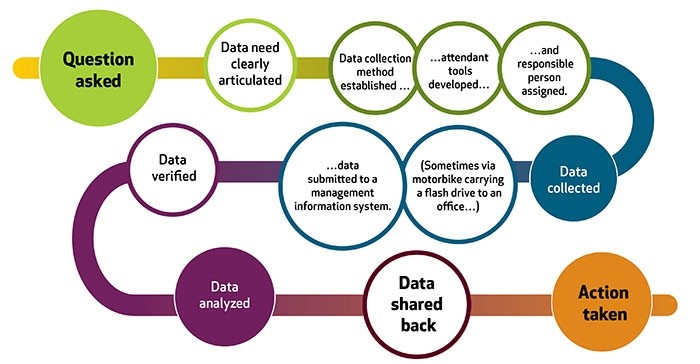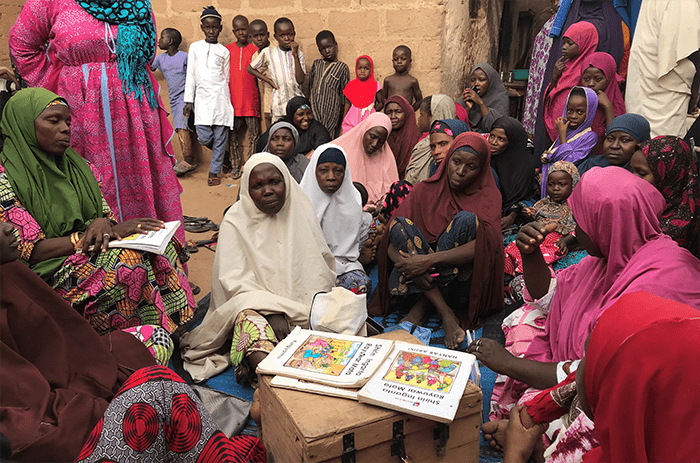Blog
Five million stories, five million lessons: How and why Pact measures its global impact

What’s behind a single data point?
This year, Pact recorded 5,008,312 data points as part of its annual Global Indicator project, which tracks 14 indicators across Pact’s portfolio of approximately 100 projects in 40 countries. The indicators focus on Pact’s core mission of supporting resilient communities to be heard, capable and vibrant, in the areas of health, governance, livelihoods, energy, natural resources, business and markets, and the cross-cutting areas of capacity development and evidenced based, data-driven learning and adaptive management.
Each of the 5 million-plus data points represents many things. To begin, they represent a rigorous, extensive and coordinated process to ensure the highest quality. This has been streamlined over nine years and includes data passed from hand to hand and continent to continent, at times by motorbike, and at other times by smart phone or advanced online platform.
In an era of Big Data, it’s easy to forget where data come from. We’re awash in data sources and methods that are transforming our world – crowdsourcing, devices that track our every click and step, and advanced analytic technologies such as machine learning, artificial intelligence and quantum computation. People often speak as if we can simply pick data off the street. “Let’s go get data for this,” is an often-heard refrain.
Ultimately, though, data come from someone or something. Often, the most important questions need data that must be purposefully collected and analyzed. From conceptualization to dissemination, the process for the 5 million data points we collected in 2019 went something like this:

And this process does not describe the labor hours, communication exchanges and opportunity costs associated with an annual global project of this scale, now in its ninth year.
Why does Pact do all this? For one thing, we recognize that – however blasé we have become about data as a society – Pact needs data not only to help with strategic decision-making, but also for transparency and accountability to the people we serve. By collecting and sharing this data freely on our website, we are being transparent about where we focus our energy and resources and are accountable for the actions we take and their results.
On another level, Pact collects this data because each of those 5 million data points is a story – a story about one part of one life. Together, they help us adapt our strategies and push us to reach more lives in more efficient and sustainable ways.
For example, one data point from among the 5 million from this past year represents a single group of women in a savings and loans group, known at Pact as a WORTH group. That single group is in turn comprised of 30 women, who in turn each have a family, a community and attendant responsibilities.
Of that one data point, we need to ask ourselves: How are the participants using those savings? How have their lives been impacted by those savings? And how did Pact contribute to that? By asking these questions, we know what we can do better next year to improve our efficiency and increase the sustainability of our impact.

For example, this WORTH group lives on the edge of Gombe town in eastern Nigeria. Through the savings and loans group set up by Pact two years ago and accompanying financial literacy support and enterprise development training, they created a group business. Thanks to their pooled savings, they bought three sewing machines and invested in materials to craft unique toiletry bags and purses that they sell together at the market. They have been so successful that they are currently in pursuit of new markets to sell their products. Also thanks to their pooled savings, they participated in a birth preparedness savings initiative and were able to support group members who needed hospitalization.
Based on this one data point from this one story, and the questions we asked of it, we know that Pact’s signature approach to savings and loans is creating value and improving lives. We also know that to sustain our impact, we need to link our WORTH program to Pact’s scalable entrepreneurship model and invest in access to our smartphone application for savings and loans, called myWORTH, which provides financial services and digital learning to groups that otherwise wouldn’t have such access. These linkages to markets, formal financial services and technical skills will support them to grow their businesses and access resources currently out of reach and in a more sustainable way. That way, we will reach more women and have more stories of improved lives next year.
This year, Pact added two more indicators, and we are embarking on a project that will greatly expand our global indicators to enable more fine-grained strategic and participatory decision-making and accountability to those we serve. This demonstrates Pact’s commitment not only to evidence-based decision-making, but also evidence-based learning and adaptation. Both are critical, especially in an era of Big Data, when the questions we ask and how we use data are more important than ever.
The right data can help us make the right decisions. The best data can also tell us a story to remind us why we are collecting them in the first place. This keeps us accountable to the people we serve, both in the past and for the future.
Pact is committed to rigorous measurement and data transparency. A handbook that defines our indicators and describes our methodology is available upon request, and our website, pactworld.org, includes interactive visualizations of our results, including historical data.
Read the full Measuring Pact's Mission 2019 report here.